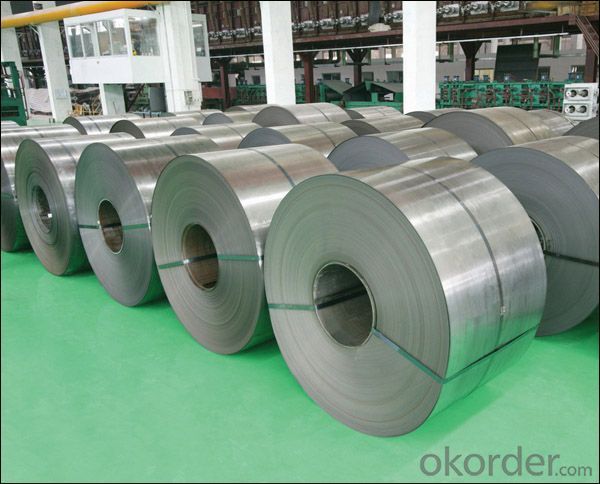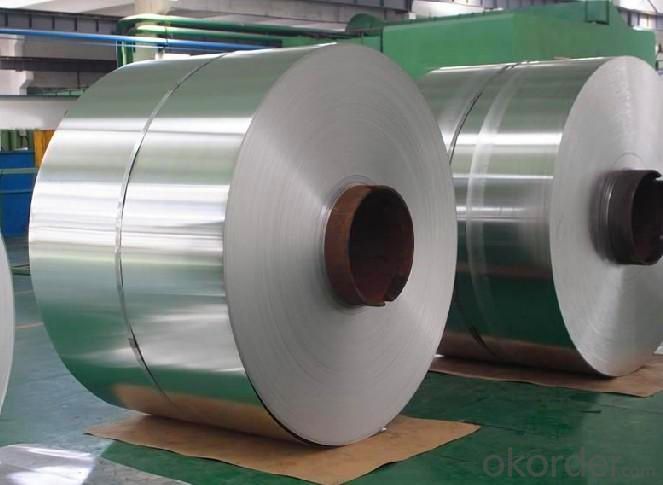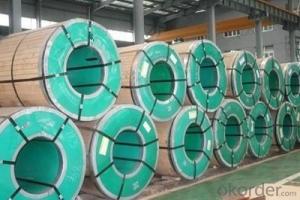Stainless Steel Coil Cold Rolled 201 with High Quality
- Loading Port:
- Shanghai
- Payment Terms:
- TT OR LC
- Min Order Qty:
- 20 m.t.
- Supply Capability:
- 10000 m.t./month
OKorder Service Pledge
OKorder Financial Service
You Might Also Like
Item specifice
1. Structure of Stainless Steel Coil Cold Rolled 201 Descriptions
Stainless Steel 201 is a new kind of Austenite stainless steel by used Mn, N replace Ni. The steel has good corrosion resistance and hot / cold processing performance, instead of 304 stainless steel products for used in the not high of corrosive environment, such as indoor, inland city outdoor etc.
2. Main Features of the Stainless Steel Coil Cold Rolled 201
Standard: JIS, SUS, AISI, ASTM
Grade: 201-J1, 201-J4, AISI201, AISI202
Finish: BA, 2B, 8K, NO.3, NO.4, HL
MOQ: 25 Metric Tons
Hardness: Low Hard(190 HV Max); Half Hard(240-280HV); Full Hard(42-60 HRC)
Ship Term: FOB any port, China or CFR Destination port
Delivery Time: 15 to 20 day after the receive the deposit or 100%LC
Payment Terms: TT 30% for deposit, Balance against the copy of B/L, or 100%LC
Packaging: By wooden pallet, wooden case or according to customer's request
3. Stainless Steel Coil Cold Rolled 201 Images


4. Stainless Steel Coil Cold Rolled 201 Specifications
Mechanical Property Contrast | YS (Mpa) | TS (Mpa) | EL(%) | HV | REMARK |
Stainless Steel 201 | 426 | 880 | 52 | 224 | 1.0t |
Stainless Steel 304 | 285 | 710 | 58 | 165 | 1.0t |
Stainless Steel 200 Series Chemicals Contrast (wt. %) | ||||||||
Chemicals | C | Si | Mn | Cr | Ni | N | Other | |
205 | 0.12-0.25 | ≤0.75 | 14.0-15.0 | 16.5-18.0 | 1.0-1.75 | 0.32-0.4 | ||
JIS, | 201 | ≤0.15 | ≤1.0 | 5.5-7.5 | 16.0-18.0 | 3.5-5.5 | ≤0.25 | - |
201L | ≤0.03 | ≤0.75 | 5.5-7.5 | 16.0-18.0 | 3.5-5.5 | ≤0.25 | - | |
202 | ≤0.15 | ≤1.0 | 7.5-10.0 | 17.0-19.0 | 4.0-6.0 | ≤0.25 | - | |
201LN | ≤0.03 | ≤0.75 | 6.4-7.5 | 16.0-17.5 | 4.0-5.5 | 0.1-0.25 | Cu≤1.0 | |
India | 201-J1 | ≤0.08 | ≤0.75 | 7.0-8.0 | 15.0-17.0 | 4.0-5.0 | ≤0.1 | Cu≤1.5 |
201-J3 | ≤0.08 | ≤0.75 | 9.0-10.5 | 14.0-16.0 | 2.0-3.0 | ≤0.15 | Cu≤2.0 | |
201-J4 | ≤0.10 | ≤0.75 | 8.5-10.0 | 15.0-16.0 | ≤1.2 | ≤0.2 | Cu≤2.0 | |
America | 204 | ≤0.03 | ≤1.0 | 7.0-9.0 | 15.0-17.0 | 1.5-3.0 | 0.15-0.3 | (Cu) |
H400 | ≤0.10 | ≤1.0 | 6.0-9.0 | 17.0-19.5 | ≤3.5 | ≤0.3 | - | |
Japan | YUS130S | 0.09 | 0.5 | 11.0 | 18.0 | 6.5 | 0.35 | - |
NTK S-4 | 0.17 | 0.43 | 14.7 | 17.7 | 1.3 | 0.35 | - | |
NM15M | 0.08 | 0.8 | 14.5 | 17.0 | 4.3 | 0.33 | - | |
Europe America | 219 | ≤0.04 | ≤0.75 | 8.0-10.0 | 19.0-21.5 | 5.5-7.5 | 0.15-0.4 | - |
Cromanite | ≤0.08 | ≤1.0 | 9.5-11.0 | 18.0-20.0 | ≤1.0 | 0.4-0.6 | - | |
201 Surface | Characteristic and Application of Stainless Steel Coil Cold Rolled 201 |
2B | The surface brightness and flatness of 2B is better than 2D then through a special surface treatment to improve its mechanical properties,2B could nearly Satisfy comprehensive uses |
No.4 | Polished with abrasive belt of grit#150#180, have better brightness with discontinuous coarse stria, but thinner than NO.3, are used as bathtub buildings inner and electrical appliances kitchen utensils and food processing. |
BA | Cold rolled, bright annealed and skin-passed, the product have excellent brightness like mirror kitchen apparatus, etc. |
8K | The product have excellent brightness and prefer bright can be the mirror. |
5. FAQ of Stainless Steel Coil Cold Rolled 201
Q: Are you factory or trader?
A: We certainly are stainless steel manufacturer and have processing plant.
Q: Can you provide mill test certificate?
A: Yes! Mill test certificate for both hot rolled raw material coils and cold rolled coils are available.
Q: Can you make DDQ (Deep drawing quality)?
A: Yes. Our material has been widely used for producing stainless steel pots and stainless steel sinks, which have strict request for good deep drawing quality.
Q: How to visit your factory?
A: Most of the main cities in the world have flight to Beijing; you can take flight to Beijing first, then we will lead you to our Wuxi mills.
Q: How about your company?
A world class manufacturer & supplier of castings forging in stainless steel, is one of the large-scale professional investment casting production bases in China, consisting of both casting foundry forging and machining factory. Annually more than 90000 tons Precision casting and forging parts are exported to markets in Europe, America and Japan. OEM casting and forging service are available, all according to customer’s requirements.
Q: How to guarantee the quality of the products?
A: We have established the international advanced quality management system,every link from raw material to final product we have strict quality test; We resolutely put an end to unqualified products flowing into the market. At the same time, we will provide necessary follow-up service assurance.
- Q:Are 111 stainless steel strips suitable for harsh chemical environments?
- No, 111 stainless steel strips are not suitable for harsh chemical environments. 111 stainless steel is a low alloy grade that does not have the same corrosion resistance as other stainless steel grades, such as 304 or 316. It is more susceptible to corrosion and damage when exposed to harsh chemicals, especially acids and chlorides. In harsh chemical environments, it is recommended to use stainless steel strips with higher alloy content and corrosion resistance to ensure durability and longevity.
- Q:Can stainless steel strips be used in the food processing industry?
- Yes, stainless steel strips can be used in the food processing industry. Stainless steel is a highly durable and corrosion-resistant material that is widely used in food processing applications. It is easy to clean, has a smooth surface that prevents the accumulation of bacteria, and is resistant to chemicals and extreme temperatures. Stainless steel strips can be used for various purposes in the food processing industry, such as conveyor belts, equipment components, food preparation surfaces, and storage containers. They meet the strict hygiene and safety standards required in the industry and are a popular choice due to their longevity and reliability.
- Q:Can stainless steel strips be used in pharmaceutical storage containers?
- Pharmaceutical storage containers can indeed utilize stainless steel strips. The pharmaceutical industry often relies on stainless steel due to its exceptional corrosion resistance and durability. It is a frequently employed material that can withstand harsh cleaning agents and disinfectants, making it highly suitable for the storage of pharmaceutical products. The use of stainless steel strips in the construction of pharmaceutical storage containers guarantees the preservation and safety of the stored drugs. Furthermore, stainless steel is non-reactive and does not release any harmful substances into the medications, ensuring their purity and efficacy. In summary, stainless steel strips are a dependable and appropriate choice for pharmaceutical storage containers.
- Q:Can 111 stainless steel strips be etched or engraved for customization?
- Yes, 111 stainless steel strips can be etched or engraved for customization.
- Q:What are the disadvantages of using stainless steel strips?
- There are various drawbacks associated with the utilization of stainless steel strips. To begin with, stainless steel strips can be considerably pricey in comparison to other materials. The elevated cost of stainless steel can make it less accessible, particularly for large-scale projects that necessitate a significant amount of material. Moreover, stainless steel strips are prone to scratches and dents. Despite its durability, stainless steel can still be vulnerable to surface damage, which can adversely impact its appearance and overall lifespan. This can pose a particular problem in situations where the strips are exposed to harsh environments or experience heavy usage. Furthermore, working with stainless steel strips can be challenging. The material's hardness can render it difficult to cut, bend, or shape according to specific requirements. Consequently, the complexity and cost of manufacturing or installation processes can increase, as specialized tools and techniques may be required. Another disadvantage of stainless steel strips is their susceptibility to corrosion. Although stainless steel is generally resistant to rust, it is not completely immune. Under certain conditions, such as exposure to saltwater or acidic substances, stainless steel can still corrode over time. Therefore, proper maintenance and regular cleaning are necessary to prevent and control corrosion. Lastly, stainless steel strips may not be suitable for certain applications due to their weight. Stainless steel is relatively heavy in comparison to other materials, which can restrict its usage in projects that require lightweight or portable solutions. This can prove to be a drawback in industries where weight reduction is a priority, such as aerospace or automotive manufacturing. In conclusion, while stainless steel strips offer numerous advantages such as durability and resistance to corrosion, they also possess several disadvantages. These include high cost, susceptibility to scratching and denting, difficulty in working with, potential for corrosion, and weight limitations. It is crucial to carefully consider these factors before deciding to employ stainless steel strips in any application.
- Q:Are stainless steel strips resistant to pitting and crevice corrosion?
- Yes, stainless steel strips are highly resistant to pitting and crevice corrosion due to their composition and protective oxide layer.
- Q:Can stainless steel strips be used in the production of architectural façades?
- Yes, stainless steel strips can be used in the production of architectural façades. Stainless steel is a durable and corrosion-resistant material that can withstand various weather conditions, making it an ideal choice for façade applications. Additionally, stainless steel offers a sleek and modern aesthetic, making it popular in contemporary architectural designs.
- Q:What is the creep resistance of stainless steel strips?
- The creep resistance of stainless steel strips refers to their ability to withstand deformation or elongation under sustained high temperatures and constant stress. Stainless steel is known for its excellent creep resistance compared to other materials. This is primarily due to its high chromium content, which forms a protective oxide layer on the surface of the steel, providing enhanced resistance to oxidation and creep deformation. Additionally, stainless steel strips often contain other alloying elements such as nickel, molybdenum, or titanium, which further contribute to their creep resistance. These alloying elements help strengthen the steel and enhance its ability to resist deformation at elevated temperatures, making stainless steel strips a reliable choice for applications where creep resistance is essential, such as in high-temperature environments or under constant stress.
- Q:How do stainless steel strips handle exposure to alkalis?
- Stainless steel strips are highly resistant to alkalis and can handle exposure to them quite well. The composition of stainless steel, with a high chromium content, forms a protective layer on the surface that prevents corrosion and chemical reactions with alkalis. This makes stainless steel strips a reliable choice for applications that involve contact with alkalis, as they can withstand and endure such exposure without significant damage.
- Q:Are 111 stainless steel strips suitable for high-pressure applications?
- High-pressure applications do not find 111 stainless steel strips suitable due to their low-carbon composition, which lacks the required strength and resistance to handle such environments. Instead, it is advised to opt for stainless steel strips of higher grades like 300 series (e.g., 304 or 316) or duplex stainless steels. These alternatives possess superior mechanical properties and corrosion resistance, making them more suitable for high-pressure applications.
1. Manufacturer Overview |
|
|---|---|
| Location | |
| Year Established | |
| Annual Output Value | |
| Main Markets | |
| Company Certifications | |
2. Manufacturer Certificates |
|
|---|---|
| a) Certification Name | |
| Range | |
| Reference | |
| Validity Period | |
3. Manufacturer Capability |
|
|---|---|
| a)Trade Capacity | |
| Nearest Port | |
| Export Percentage | |
| No.of Employees in Trade Department | |
| Language Spoken: | |
| b)Factory Information | |
| Factory Size: | |
| No. of Production Lines | |
| Contract Manufacturing | |
| Product Price Range | |
Send your message to us
Stainless Steel Coil Cold Rolled 201 with High Quality
- Loading Port:
- Shanghai
- Payment Terms:
- TT OR LC
- Min Order Qty:
- 20 m.t.
- Supply Capability:
- 10000 m.t./month
OKorder Service Pledge
OKorder Financial Service
Similar products
New products
Hot products
Related keywords































